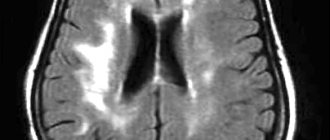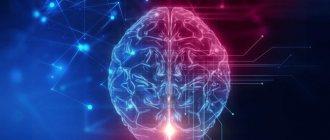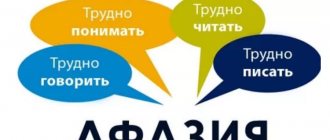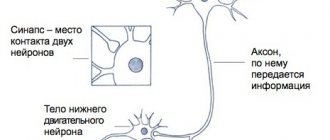According to the classification of A.R. Luria, various forms of aphasia can be distinguished: Efferent motor aphasia (otherwise Broca's aphasia after the doctor who described the symptoms of the disease) occurs against the background of damage to the lower parts of the premotor cortex of the left hemisphere of the brain. Motor aphasia is characterized by a telegraphic style of utterances (disintegration of grammar), as well as difficulties in switching from one word or phrase to another. Another characteristic feature of the manifestation of motor aphasia is impairment of writing and reading; The manifestation of dynamic aphasia is characterized by the impossibility of constructing an internal program of utterance (disintegration of internal speech). This disorder causes damage to the prefrontal region of the left hemisphere; Sensory aphasia (otherwise Wernicke's aphasia) is based on damage to the cortical part of the auditory analyzer. With sensory aphasia, the patient loses the ability to interpret the speech he hears; The development of afferent motor aphasia leads to damage to the parietal and posterior-central areas of the cortex. At the same time, patients with aphasia experience difficulties due to the inability to distinguish sounds that are close in articulation due to incorrectly selected articulatory postures, which leads to mixing of articles within the group; Optical-mnestic aphasia is characterized by weakness of visual images of words and impaired visual memory. People with aphasia have difficulty naming words; Acoustic-mnestic aphasia is caused by a narrowing of the volume of auditory-verbal memory and a violation of the volume of retention of auditory-verbal information; Amnestic aphasia is caused by lesions in the parietotemporal region, and the main difficulty is naming familiar objects; Semantic aphasia is characterized by defects in simultaneous synthesis and analysis of speech, as well as impaired understanding of complex logical-grammatical structures that describe spatial relationships. A simplified classification of forms of aphasia can be reduced to: Motor, when a patient with aphasia understands speech, but cannot speak; Sensory, when the patient does not understand the meaning of words, but can pronounce phrases and words. A common distinguishing feature of patients with aphasia is poverty of speech, in which they extremely rarely use adverbs, adjectives, descriptive phrases, and they practically do not use sayings and proverbs.
Peculiarities
Motor aphasia is brain damage in Broca's area, which is characterized by irreversible organic changes in brain tissue with a complete loss of its functional activity in this area. Experts distinguish two main clinically significant forms of motor aphasia: afferent and efferent motor aphasia. With this disease, there is a disruption of the synthetic activity of the brain with loss of speech function, together with its perception. In this case, the patient has no situational speech, i.e. the patient cannot maintain a dialogue because he simply does not perceive it.
Afferent motor aphasia
Afferent or kinesthetic aphasia is manifested by difficulty in reproducing speech, mainly due to problems in the articulatory apparatus. Thus, patients with afferent motor aphasia cannot and cannot connect their own speech into a complete structured sentence.
Patients often try to replace words that they cannot pronounce with synonyms, which leads to a significant slowdown in spoken speech. The difficulty in pronouncing consonant sounds also attracts attention.
In most cases, afferent motor aphasia is combined with agraphia, a writing disorder.
Efferent motor aphasia
It occurs as a result of damage to the premotor areas of the cerebral cortex. Efferent motor aphasia manifests itself by literally jamming the patient’s speech on specific sounds. The patient cannot change the position of the articulatory apparatus, which leads to large time pauses between pronounced sounds. Speech becomes telegraphic or stamped.
It is worth noting that in almost half of all cases of identified motor aphasia in patients, a combination of both afferent and efferent aphasia occurs. Mixed aphasia is manifested by a complex manifestation of all of the above manifestations, which is called the term sensorimotor speech disorder.
Classification of aphasia
This disorder is classified according to psychological, linguistic and anatomical factors. Today, doctors mainly use the A.R. division. Luria, which is based on the location of the affected area in the dominant hemisphere and the nature of speech disorders. Types of aphasia :
- dynamic
- amnestic-semantic
- acoustic-mnestic
- acoustic-gnostic
- motor (afferent or efferent subtype)
Efferent motor aphasia occurs when the patient's so-called Broca's area is affected. The patient cannot switch from one articulatory position to another, which is called kinetic articulatory apraxia. The afferent subtype of motor aphasia occurs when the lower parts of the postcentral cortex, which is adjacent to the Rolandic sulcus, are affected. This type is characterized by kinesthetic articulatory apraxia.
The amnestic-semantic type of aphasia is caused by damage to the anterior parietal and posterior temporal parts of the cerebral cortex. The patient forgets what names phenomena and objects have. It becomes difficult for him to understand long grammatical structures. He understands simple speech better.
The acoustic-mnestic type of speech disorder is caused by damage to the middle temporal gyrus. The patient's auditory-verbal memory becomes worse or completely disappears. In some cases, there are no visual representations of objects.
When Wernicke's area is affected, an acoustic-gnostic type of aphasia . A person does not understand speech addressed to him, since there is a violation of synthesis, analysis, and phonemic hearing. If the posterior frontal parts of the brain are damaged, dynamic aphasia , in which the patient’s communicative speech function is impaired.
The total form of the disorder in question is recorded when the damage to the cortex of the dominant hemisphere is very extensive. In some cases, mixed types of disorders are recorded.
Causes of afferent motor aphasia
The causes of the formation of motor afferent aphasia are a number of diseases that lead to organic damage to the cerebral cortex, including Broca’s area, as well as the premotor cortex. Most often, afferent aphasia is caused by diseases with extensive damage to brain structures, for example:
- Acute cerebrovascular accident or stroke. Moreover, a stroke is hemorrhagic in nature, in which massive hemorrhage occurs in the structures of the brain. Blood soaking and compression of the posterior regions of the frontal zone leads to damage to Broca's center and the development of afferent motor aphasia;
- Infectious and inflammatory diseases of the brain. Most often these include encephalitis or leukoencephalitis. Inflammatory diseases lead to softening of brain tissue and the formation of abscess cavities;
- Traumatic brain injuries, especially with severe brain contusion and subarachnoid hemorrhage. Brain contusion and edema lead to compression of brain structures, which can also damage Broca’s center;
- Development of a tumor process localized in the frontal or temporal lobes on the side of the dominant hemisphere;
- Epilepsy, in the presence of an epileptogenic focus in close anatomical proximity to the speech center of the brain;
- Toxic damage to brain structures, for example, from heavy metals or other poisons.
A number of chronic diseases also contribute to the development of afferent motor aphasia:
- Chronic pathology of blood circulation, due to the presence of an aneurysm or atherosclerotic changes in the vascular wall of the cerebral arteries.
- Slowly progressive diseases of the central nervous system: multiple sclerosis or encephalomyelitis. Demyelination of nerve fibers leads to disruption of afferent and efferent connections of the speech center with other structures of the brain;
- Formation of prion protein.
Read also
Arnold-Chiari malformation
Due to the availability of the study and the high resolution of MRI, we quite often come across the conclusion - Arnold-Chiari anomaly.
What is meant by this concept? Arnold-Chiari malformation... Read more
Amyotrophy
The word atrophy, translated from Latin, means loss or decrease in the volume of muscle mass or an individual muscle. Most often, muscle atrophy occurs due to limitation of active movements, for example, after...
More details
Ankylosing spondylitis/ankylosing spondylitis
Ankylosing spondylitis (ankylosing spondylitis) is a chronic inflammatory disease of the spine and joints, accompanied by progressive pain, stiffness and limited movement at the beginning...
More details
Lambert-Eaton syndrome
The first description of the disease in the literature appeared in 1953. J. Anderson described a case from practice: a 47-year-old man with lung cancer experienced symptoms similar to myasthenia gravis. After tumor removal...
More details
Rehabilitation
Restoration of the body after diseases of the central and peripheral nervous system, operations on the brain and spinal cord, conditions after removal of the mammary gland due to a tumor, consequences...
More details
Symptoms
Afferent aphasia is accompanied by the occurrence of a number of symptoms and syndromes, which form the clinical picture characteristic of this form. Expressive language impairment syndrome includes:
- Violation of spatial movements, such as facial expressions and gestures, as well as a complete absence of situational speech process. When trying to repeat sounds, the patient makes only isolated movements with his lips and tongue;
- Speech becomes overly clichéd, there are syllable and sound dropouts.
The patient also experiences pronounced difficulties in pronouncing complex syllables, namely: they divide words into parts and skip the most complex sounds. There is a violation of the understanding of someone else's speech, however, this period does not last long from a day to several days and occurs after suffering an acute cerebrovascular accident.
The victim’s spatial disorientation, as well as impairment of writing and perception of visual text information, are also noteworthy. When writing, the patient shifts vowels, omits consonants, and changes the order of letters.
Types of aphasia, their symptoms and features
Today, there are several types of classification of aphasia. Based on anatomical, psychological and linguistic criteria, there are classical divisions of forms of the disease, neurological, linguistic, etc.
A. R. Luria most fully revealed the issue of dividing aphasia by type, ultimately identifying six varieties of this disease. Its classification is still considered the most comprehensive and generally accepted in world practice. According to this neuropsychological division, the following forms of aphasia are distinguished:
- afferent motor;
- efferent motor;
- acoustic-gnostic (sensory);
- acoustic-mnestic;
- semantic aphasia;
- dynamic.
These forms are generally classified into three large groups. Thus, afferent, efferent and dynamic forms of aphasia are classified as a group of motor disorders. A distinctive feature of this type of disease is the absence of expressive speech, that is, active oral utterance.
Acoustic-gnostic and semantic aphasia belong to the group of impressive disorders, where a person is unable to understand spoken language. If the patient is unable to name individual objects, acoustic-mnestic aphasia or an amnestic form of the disease occurs.
Different parts of the brain are responsible for one or another element of the structure of our speech. The form of the disease will depend on where the lesion is located. The division of aphasia into types is explained by the different ways and degrees of its manifestation. With the total form of the disease, complete recovery of the patient is almost impossible.
Afferent aphasia
With this form of the disease, a person cannot utter almost a single word. In severe or total form of manifestation, the patient is not able to utter even a sound. However, a person can involuntarily pronounce words and sounds. But he will not be able to do this when asked to repeat this or that sound or word. The patient cannot imagine how to close or open his mouth, where to place his tongue, etc. That is, the person cannot understand what exactly needs to be done to make any sound.
Afferent motor aphasia provokes a breakdown of connections between the human articulatory apparatus and sound expressions. If it is possible to pronounce any sounds, an adult or a child may confuse those that are similar in pronunciation, for example, “b” and “p” or “k” and “x,” etc. It also manifests itself in the difficulty of writing letters in the correct order. This phenomenon is especially often observed in retrained left-handers. They can skip only vowels or only consonants in words.
The disease leads to the patient's inability to express his articulatory abilities. Such people, as a rule, cannot fold their tongue into a tube, click their tongue, or make other linguistic gestures.
Efferent
Efferent motor aphasia is caused by a disorder in the part of the cerebral cortex that is responsible for programming speech, when one sound or syllable flows into another, resulting in the formation of words. This part of the brain is called Broca's area. Therefore, this form of aphasia is often called Broca's aphasia.
In this case, a person, at the request or of his own free will, can pronounce individual sounds. However, such patients cannot combine sounds into words, switch from one syllable to another to form a whole word, or such speech actions are given to them with great difficulty. In severe forms of the disease, a person begins to communicate using gestures and facial expressions or using the so-called word embolus. That is, the patient can utter one word, which he uses for all questions, requests or appeals to him.
With a less pronounced form of efferent aphasia, the patient’s speech becomes scanty and simple. Such a person does not use prepositions and cannot change words according to cases. Often this type of aphasia is characterized by a mixture of syllables and letters in the patient’s phrases. Efferent motor aphasia may result in a person's inability to read aloud.
Acoustic-gnostic (sensory)
Acoustic-gnostic, or sensory, aphasia occurs as a result of damage to the upper part of the temporal cortex of the brain. It is this area, which is called Wernicke’s area, that is responsible for a person’s perception and understanding of the auditory part of speech. In a person with this form of the disease, the phonemic analysis of spoken words is impaired. That is, the patient only partially or completely does not understand the speech addressed to him.
At the same time, physical hearing in such people is not impaired. They can put syllables into words and speak. They easily pronounce simple and familiar words, but are unable to verbally reproduce complex and unfamiliar ones. With this type of aphasia, a person's speech is simple but confused. It is very difficult to understand the meaning of what was said due to a violation of the structure of the composed sentence.
Often these patients speak very quickly, emotionally, but incoherently. You might think that a person speaks some kind of “his own” language. People with this form of the disease lose the ability to write words and sentences or read aloud. With such aphasia, the patient himself may not be aware of the speech impairment. He does not understand that he is making mistakes in the pronunciation of words, syllables or letters.
Acoustic-mnestic
Amnestic aphasia is manifested by a violation of auditory-verbal memory. The patient exhibits forgetfulness. A person knows exactly the purpose of an object, but does not remember what it is called and cannot name it. “Well, this one, call, hello, I have one like this at home, how did I forget?” (Phone) “I like it so yellow, juicy, with segments, they also peel it, and it smells delicious” (Orange). Patients do not understand the meaning of synonyms, antonyms, and cannot find a generalizing word for a group of concepts (furniture, shoes, toys).
The figurative meaning of words is also incomprehensible to a patient with this form of aphasia. Thus, he perceives the phrase “golden hands” as “hands made of gold.” This type of disorder occurs against the background of pathology of the inferior temporal region of the hemisphere.
The main characteristic of this form of aphasia is expressed in vocabulary deficit. The speech of such people is spontaneous and emotional and mainly contains verbs. Acoustic-mnestic aphasia is often accompanied by defects in counting and other arithmetic operations. Moreover, such patients read well. In contrast to the sensory form of the disease, acoustic-mnestic aphasia is characterized by preservation of phonemic hearing.
Semantic
This form of the disease occurs when the inferior parietal lobe of the hemisphere is affected. Semantic aphasia is manifested by the patient's inability to compare time and space. Such people understand speech perfectly, speak well and correctly, and fulfill simple requests. Semantic aphasia provokes a violation in the understanding of logical connections in speech structures. Patients do not understand the meaning of prepositions that determine location. The words “run”, “run”, “run away”, “run” are equivalent for them.
In addition, it is difficult for them to grasp the concepts of belonging, for example, “daddy’s daughter” and “daughter’s daddy,” etc. Patients with semantic aphasia do not understand the figurative meaning of words, sayings, and proverbs. With this type of aphasia, patients are able to read, but cannot retell what they read in their own words.
Dynamic
Dynamic aphasia is another type of motor aphasia, when the area of the brain located next to Broca's area is affected. These are the anterior and middle sections of the inferior frontal gyrus. The speech activity of the patient with this type of aphasia is reduced. It seems that the speaker does not want to engage in dialogue.
The patient's speech is scanty, spontaneous and slow, there is no dynamics or expressiveness in it. There is an absence of verbs, prepositions, complex adjectives and interjections in the phrases. The words are not consistent with each other, the grammatical forms of the words are not consistent “Grandma...read...book.” “The dog...sit..barked...now.”
Very often, a patient experiences several forms of aphasia at once. The mixed form is formed due to the anatomical proximity of those areas of the brain that are responsible for the perception and reproduction of speech. Thus, with extensive damage to the blood vessels of the brain, a mixed type of disease occurs - sensory-motor aphasia. The patient has no phonemic hearing and articulation is impaired. Understanding of oral and written speech is completely impaired.
Sensorimotor aphasia refers to the total form of the disease. Each type of aphasia is characterized by certain symptoms. But with any form of the disease, speech impairment is necessarily observed.
Diagnostics
The diagnostic search is aimed at identifying the underlying disease or cause that served as the impetus for the development of motor afferent aphasia. The diagnostic plan includes a standard set of studies. The first step is to collect an anamnesis of the disease, after which a topical diagnosis is carried out to determine the expected extent of damage to brain tissue, then a preliminary diagnosis is made.
To clarify it, a number of instrumental studies are carried out, such as:
- Magnetic resonance imaging of the brain, and contrast can also be used to improve brain imaging characteristics. Magnetic resonance imaging allows you to identify oncological lesions, the presence and volume of a hematoma in traumatic brain injury;
- Angiography of cerebral arteries for the presence or absence of vascular pathology;
- Ultrasound Doppler examination of neck vessels;
- Lumbar puncture if there is suspicion of encephalitis, meningitis or leukoencephalitis;
- Electroencephalography to exclude pathology of an epileptiform nature or oncological lesions of the brain.
The Clinical Brain Institute is focused on studying, diagnosing and treating patients with neurological symptoms, including patients with motor aphasia. The Clinical Institute of the Brain operates a powerful and modern diagnostic department, which makes it possible to make correct diagnoses with a high degree of probability.
Treatment
The main treatment should be aimed at eliminating the underlying cause that led to the formation of afferent motor aphasia. Depending on the underlying pathology, treatment tactics will differ significantly.
- In the presence of a tumor process, surgical intervention on the brain or a course of radiation and chemotherapy.
- In the presence of an infectious focus or abscess, drainage in combination with antibacterial therapy and the use of general stabilizing drugs.
- In case of acute cerebrovascular accident - a course of treatment with drugs with nootropic effects, antioxidants, angioprotectors. For hemorrhagic stroke with severe compression of the brain - surgical treatment.
- For epilepsy, the main therapy is aimed at the use of anticonvulsants.
- For demyelinating and degenerative processes in nervous tissue, glucocorticosteroids are used.
All of the above treatment regimens will be effective in the treatment of aphasia, as they have a pathogenetic mechanism for correcting the pathological manifestations of the disease.
Rehabilitation
It is very important that the treatment is comprehensive and closely related to rehabilitation measures. The Clinical Institute of the Brain is one of the first centers in the country that began the combined use of therapeutic and rehabilitation measures. Rehabilitation consists of:
- Systematic visits to a speech therapist, at least three times a week;
- Dual mode operation, i.e. both with a specialist and independently.
Rehabilitation classes are aimed at restoring articulate speech; for this, patients sing songs and read poetry, since during these classes words are stretched into syllables and train the patient’s articulatory apparatus. Separately, it is worth mentioning the restoration of writing; for this, patients write letters under dictation.
For a more effective and quick recovery of the patient, it is necessary to involve close relatives and friends in treatment. The patient should not be allowed to remain and be in social isolation for a long time.
At the Clinical Institute of the Brain, there is a specialist aphysiologist who develops individual programs for each individual patient to restore speech and writing function in cases of severe cognitive disorders.
Adviсe
Aphasia is not a mental illness, even if there are severe speech impairments. It is worth treating the patient with understanding and patience. You should not raise your voice at the patient, as this will not improve the understanding of the information and the meaning of what is being said. You should speak to the patient as slowly as possible, without using complex structures in sentences. Gestures should also be limited. Use questions that can be answered with a clear yes or no.
To improve the perception of information by patients, try to exclude all extraneous noise. Try not to limit the patient’s communication and ask him more questions.
ACOUSTIC-MNESTIC APHASIA
Acoustic-mnestic aphasia occurs when the middle and posterior parts of the temporal region are damaged. It is believed that it is based on a decrease in auditory-verbal memory, which is caused by increased inhibition of auditory traces. Acoustic-mnestic aphasia is characterized by a dissociation between the relatively intact ability to repeat individual words and the impaired ability to repeat three or four unrelated words (for example: hand-house-sky, etc.)
In acoustic-mnestic aphasia, speech memory impairment is the main defect, because phonemic hearing and the articulatory side of speech are preserved. Increased speech activity compensates for communication difficulties. The auditory verbal memory of these patients is characterized by great inertia.
Violation of the volume of retention of speech information, its inhibition leads to difficulties in understanding in this form of aphasia long, polysyllabic statements consisting of five to seven words. Patients find it difficult to navigate a conversation with two or three interlocutors, “switch off” in a difficult speech situation, cannot attend reports, lectures, and get tired when listening to music and radio broadcasts. This fact should be taken into account when prescribing such treatment methods as “art therapy”, etc.
With optical aphasia, the second variant of acoustic-mnestic aphasia, difficulties arise in retaining the semantic aspect of speech by ear; they consist in weakening and impoverishment of visual representations of an object, in the relationship between what is perceived by ear and its visual representation. The visual representation of an object becomes incomplete; those elements of objects that, on the one hand, are specific to them, and on the other hand, are associated with the polysemy of the word (for example, the words spout, comb, pen) are not completed.
Patients understand the meaning of individual words. They do not have articulatory difficulties, they are not only verbose, but also hyperactive. However, with all this, they only partially understand speech due to the narrowing of auditory-verbal memory to 1-2 out of 3 words perceived by ear. Speech is abundant, little informative, replete with verbal paraphasias, but intonation-colored.
In written speech with acoustic-mnestic aphasia, the phenomena of expressive agrammatism appear more prominently, i.e. displacement of prepositions, as well as inflections of verbs, nouns and pronouns, mainly in gender and number. The nominative side of written speech turns out to be more preserved. When recording text from dictation, patients experience significant difficulties in retaining even a phrase in their auditory-verbal memory. Consisting of three words, they are asked to repeat each fragment of the phrase.
With acoustic-mnestic aphasia, it is difficult to perceive printed text when reading. This is due to impaired preservation of auditory-verbal memory.
Prevention of afferent and efferent motor aphasia
There is no specific prevention for the development of aphasia. All preventive measures are primarily aimed at eliminating risk factors that increase the risk of vascular diseases. Since acute cerebrovascular accident is the most common cause of aphasia, stroke prevention has an indirect effect on the development of aphasia.
Timely treatment of arterial hypertension, correction of the blood lipid profile, as well as annual preventive examinations will help to avoid extensive brain damage.
As with any other disease, prevention implies:
- Maintaining a healthy lifestyle;
- Proper nutrition;
- Normalization of the work-rest regime;
- Rejection of bad habits.
Causes of the disease
This disease is caused by disorders that occur in one or another area of the cerebral cortex. Such an imbalance can be caused by both pathological changes in parts of the brain and the presence of a somatic disease.
The main causes of aphasia:
- Neoplasms in the head (tumors).
- Chronic or acute cerebrovascular accident (stroke).
- Various traumatic brain injuries.
- Presence of an abscess in the brain.
- Multiple sclerosis, encephalomyelitis. In these diseases, the myelin protein, which ensures the passage of nerve impulses through the fibers, disintegrates.
- Epilepsy, in which, due to sudden electrical discharges in the cerebral cortex, its normal functioning is disrupted.
- Disturbance of the structure of brain tissue. These include Alzheimer's disease, Pick's disease, Creutzfeldt-Jakob disease, etc.
- Other inflammatory diseases affecting the cerebral cortex.
In some cases, aphasia occurs as a complication of neurosurgical operations, poisoning with heavy poisons, and also as a result of chronic brain dysfunction.
People who have a genetic predisposition to the disease are at risk. The onset of the disease can be triggered by heart defects, chronic high blood pressure, rheumatism, and hemorrhages. Speech reproduction disorders are often observed in older people.
Forecast
Despite the fact that with aphasia it is impossible to achieve radical treatment and full restoration of the functional activity of the damaged area, nevertheless, proper treatment and compliance with recommendations and rehabilitation measures lead to a significant improvement in the patient’s quality of life. When carrying out a full course of treatment and rehabilitation, the patient can be almost completely adapted to communicating with others.
Clinical Brain Institute Rating: 5/5 — 4 votes
Share article on social networks
Programs:
Stroke Prevention
Outpatient diagnostic
Rehabilitation programs
Diagnosis of swallowing disorders and correction
Restoration and correction of speech disorders











